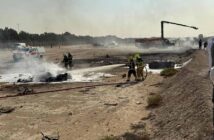
The crash of a HAL Tejas fighter jet from the Indian Air Force crashed during a demonstration flight at the Dubai Airshow, resulting in the death of the pilot, Namansh Syal, and the cancellation of the event’s final day.
The incident, which occurred in front of spectators, involved the aircraft bursting into flames after losing control mid-air, with no injuries reported on the ground is the latest in a series of fatal accidents at airshows worldwide, where high-risk aerobatic displays have led to significant loss of life over decades.
- Sknyliv Airshow Disaster (27 July 2002, near Lviv, Ukraine): A Ukrainian Air Force Sukhoi Su-27 lost control during a low-altitude aerobatic manoeuvre known as a “rolling dive” and crashed into the airfield, striking parked aircraft and causing a massive explosion that engulfed spectators. The accident killed 77 people, including 28 children, and injured 543 others, making it the deadliest airshow crash on record.
- Ramstein Airshow Disaster (28 August 1988, US Ramstein Air Base, West Germany): Three Italian Air Force Aermacchi MB-339 jets from the Frecce Tricolori aerobatic team collided mid-air during a tight formation flyover, with one aircraft crashing into the crowd on the runway, igniting a fireball and debris that also struck a medical evacuation helicopter. It resulted in 70 deaths (3 pilots and 67 spectators) and 356 severe injuries, with nearly 500 more requiring hospital treatment.
- Golden West Sport Aviation Show Crash (24 September 1972, Sacramento, California, USA): A privately owned Canadair Sabre Mk. 5 fighter failed to gain sufficient altitude on takeoff, clipped a chain-link fence at the runway’s end, crossed a nearby road, and slammed into an ice cream parlor where a Little League football team was gathered. The impact killed 22 people (including 14 children) and injured 28.
- Reno Air Races Crash (16 September 2011, Reno, Nevada, USA): A modified P-51D Mustang racing plane, piloted by Jimmy Leeward, suffered a structural failure in its tail elevator due to excessive modifications, causing it to pitch up uncontrollably and plummet into the spectator box seats. The crash claimed 11 lives (the pilot and 10 spectators) and injured 69 others.
- Ostend Airshow Crash (26 July 1997, Ostend, Belgium): A Walter Extra EA-300 aerobatic aircraft from the Royal Jordanian Falcons team, flown by Captain Omar Hani Bilal, lost control during a performance and crashed at the runway’s end near a Red Cross tent and spectator stands, erupting in flames upon impact. It killed 9 people (the pilot and 8 spectators) and injured 40.
- Paris Airshow Tu-144 Crash (3 June 1973, Le Bourget Airport, Paris, France): The Soviet Tupolev Tu-144 supersonic airliner, on its first public demonstration flight, disintegrated mid-air due to a combination of pilot error, mechanical failure, and possible sonic boom interference from a pursuing French Mirage jet. Debris struck a village, killing 14 people (6 crew and 8 on the ground) with no reported injuries.
- Canary Islands Airshow Crash (8 April 1984, Los Rodeos Airport, Tenerife, Spain): A Spanish Air Force aerobatic team member lost control of his aircraft shortly after takeoff, causing it to dive into the runway, catch fire, bounce along the tarmac, hit a wooden barrier, and collide with spectators. The incident resulted in 5 deaths (the pilot and 4 spectators) and 14 injuries.
- Syerston English RAF Airshow Crash (20 September 1958, Syerston, Nottinghamshire, England): A prototype Avro Vulcan bomber, undergoing a test climb during an airshow, suffered a catastrophic failure when its starboard wing disintegrated, sending the aircraft into a dive that crashed near the runway. All 4 crew members died, and 3 spectators sustained injuries.
- Bartlesville Biplane Exposition Collision (2 June 1996, Bartlesville, Oklahoma, USA): During landing at a biplane-focused event, two aerobatic aircraft clipped wings mid-air; one banked to return to the airport while the other struck it from behind, shearing off both wings and causing an explosion on the ground. The mid-air collision killed 4 pilots with no other injuries reported.
- Indian Air Force Day Parade Crash (8 October 1989, New Delhi, India): An Indian Air Force Mirage 2000, flown by Wing Commander Ramesh Bakshi, struck the ground while performing the low-altitude “Downward Charlie” manoeuvre involving rolls, leading to fire and explosions that affected nearby spectators. It resulted in 2 deaths and 12 injuries.







